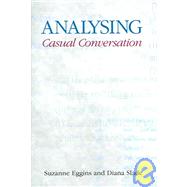
| List of Figures | viii | ||||
| List of Tables | ix | ||||
| List of Texts | xi | ||||
| Preface | xiii | ||||
| Introduction: Collecting and transcribing casual conversation | 1 | (5) | |||
| 1 Making meanings in everyday talk | 6 | (17) | |||
|
6 | (2) | |||
|
8 | (8) | |||
|
16 | (3) | |||
|
19 | (2) | |||
|
21 | (1) | |||
|
21 | (2) | |||
| 2 Relevant approaches to analysing casual conversation | 23 | (44) | |||
|
23 | (1) | |||
|
23 | (2) | |||
|
25 | (8) | |||
|
33 | (7) | |||
|
40 | (3) | |||
|
43 | (15) | |||
|
58 | (8) | |||
|
66 | (1) | |||
| 3 The grammar of casual conversation: enacting role relations | 67 | (49) | |||
|
67 | (1) | |||
|
67 | (5) | |||
|
72 | (2) | |||
|
74 | (10) | |||
|
84 | (11) | |||
|
95 | (1) | |||
|
96 | (2) | |||
|
98 | (8) | |||
|
106 | (2) | |||
|
108 | (5) | |||
|
113 | (1) | |||
|
114 | (2) | |||
| 4 The semantics of casual conversation: encoding attitude and humour in casual conversation | 116 | (53) | |||
|
116 | (1) | |||
|
116 | (8) | |||
|
124 | (19) | |||
|
143 | (12) | |||
|
155 | (12) | |||
|
167 | (2) | |||
| 5 The discourse structure of casual conversation: negotiating support and confrontation | 169 | (58) | |||
|
169 | (1) | |||
|
169 | (8) | |||
|
177 | (3) | |||
|
180 | (11) | |||
|
191 | (23) | |||
|
214 | (1) | |||
|
215 | (10) | |||
|
225 | (2) | |||
| 6 Genre in casual conversation: telling stories | 227 | (46) | |||
|
227 | (1) | |||
|
227 | (3) | |||
|
230 | (6) | |||
|
236 | (28) | |||
|
264 | (5) | |||
|
269 | (1) | |||
|
270 | (3) | |||
| 7 Gossip: establishing and maintaining group membership | 273 | (39) | |||
|
273 | (1) | |||
|
274 | (4) | |||
|
278 | (1) | |||
|
279 | (5) | |||
|
284 | (14) | |||
|
298 | (7) | |||
|
305 | (5) | |||
|
310 | (2) | |||
| 8 Conclusion | 312 | (5) | |||
|
312 | (1) | |||
|
312 | (2) | |||
|
314 | (2) | |||
|
316 | (1) | |||
| References | 317 | (10) | |||
| Index | 327 |
The New copy of this book will include any supplemental materials advertised. Please check the title of the book to determine if it should include any access cards, study guides, lab manuals, CDs, etc.
The Used, Rental and eBook copies of this book are not guaranteed to include any supplemental materials. Typically, only the book itself is included. This is true even if the title states it includes any access cards, study guides, lab manuals, CDs, etc.